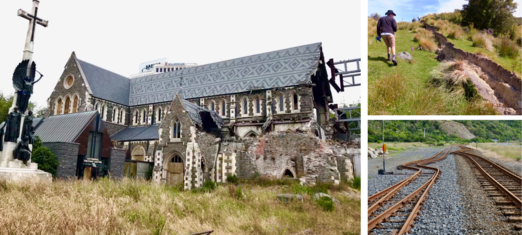New Zealand and Japan lie on subduction zones along the Pacific ‘Ring of Fire’. Both countries have the highest level of seismic activities and suffered destructive earthquakes recently, In New Zealand, the 2011 Christchurch earthquake (Mw6.1) caused 185 deaths and many buildings severely damaged. The 2016 Kaikoura earthquake (Mw7.8) ruptured over 20 surface faults in a 150 km range and it was described as "most complex earthquake ever studied". While in Japan, the 2011 Great East Japan Earthquake (Mw9.0) caused over 20,000 dead or missing. The 2016 Kumamoto earthquakes (Mw 6.2/ 7.0) ruptured a 30-km length fault and caused over 50 deaths.

ChristChurch Cathedral remains the effects of the 2011 Christchurch earthquake (left). Surface raised 1 m on Stone Jug fault, one of 20 co-seismic faults (right top), and railway curved (right bottom) during the 2016 Kaikoura earthquake.
After the 2013 Sendai symposium of Probabilistic Seismic Hazard Assessment(PSHA), Dr. Matt Gerstenberger, the GNS project leader of national seismic hazard model shows great interests in PSHA issues. Under the lessons learnt from the destructive earthquakes and the awareness of the unexpected earthquake possibly occur in the future, scientists on both sides have consensus of cooperative researches to share data, knowledge and information.
NIED, GNS and U. Otago have conducted a joint research on the near-fault strong motion of the 2016 Kaikoura earthquake. On-site and helicopter reconnaissance on the earthquake faults revealed a perspective of the complicated fault rupture (link to a movie provided by Dr. Ken X Hao).




